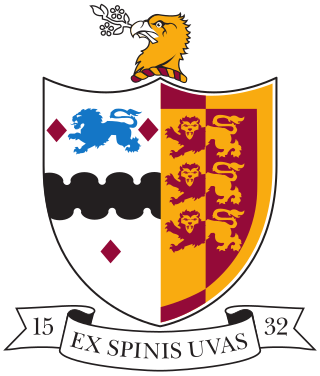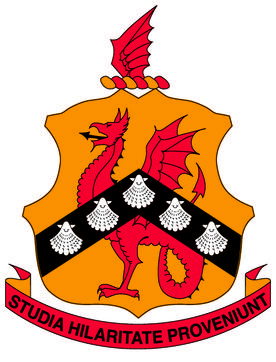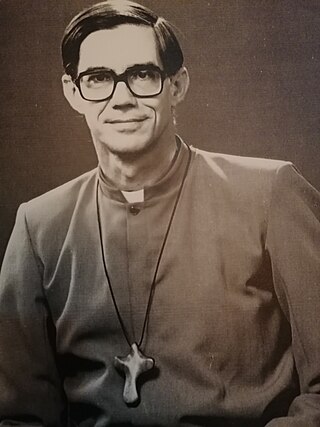History
The school was established by Mother Cecile of Grahamstown in October 1884 (though not in its present premises). Mother Cecile was the founder of the Community of the Resurrection of our Lord (also known as the CR Sisters). In 1918, the CR Sisters purchased the current building in Huntley Street, and the Good Shepherd School moved into its current home.
The Huntley Street Building was built in 1844, and was—from 1849—the St. George's Grammar School. St. George's Grammar School was founded by Robert Gray, Bishop of Cape Town. F. Bankes, a priest, was the first headmaster; he later became the first headmaster of St. Andrew's College.
The school is situated near the centre of the city's business area. In spite of this, the school is populated predominantly by disadvantaged learners. The school's medium of instruction is English. The school caters for girls and boys from grade 1 to 7 (ages 6– 13).
Recent developments
Through funds secured from PetroSA in 2010, the new classroom block was built and the administration block totally refurbished to provide for a staff room, library, computer lab, kitchen (from where the school nutrition programme is run), and a meeting room. [2]
Good Shepherd School has a rich tradition as an Anglican school. As a Public School on Private Property, the Good Shepherd Trust has stewardship of the school buildings and property. The Good Shepherd Trust, along with the staff, the School Governing Body, and parents, is looking to provide excellent education by rediscovering the riches of the school's tradition as a church school with a strong religious ethos as its foundation.

Bristol Grammar School (BGS) is a 4–18 mixed, private day school in Bristol, England. It was founded in 1532 by Royal Charter for the teaching of 'good manners and literature', endowed by wealthy Bristol merchants Robert and Nicholas Thorne who made their money through the work and trade of enslaved Africans. The school flourished in the early 20th century under headmaster Sir Cyril Norwood (1906–1916), embodying "the ideals and experiences of a leading public school". Norwood went on to serve as the master at Marlborough College and Harrow, and as president of St John's College, Oxford.

Sir Herbert Baker was an English architect remembered as the dominant force in South African architecture for two decades, and a major designer of some of New Delhi's most notable government structures. He was born and died at Owletts in Cobham, Kent.

Makhanda, formerly known as Grahamstown, is a town of about 75,000 people in the Eastern Cape province of South Africa. It is situated about 110 kilometres (70 mi) northeast of Gqeberha and 130 kilometres (80 mi) southwest of East London. It is the largest town in the Makana Local Municipality, and the seat of the municipal council. It also hosts Rhodes University, the Eastern Cape Division of the High Court, the South African Library for the Blind (SALB), a diocese of the Anglican Church of Southern Africa, and 6 South African Infantry Battalion. Furthermore, located approximately 3 km south-east of the town lies the world renowned Waterloo Farm, the only estuarine fossil site in the world from 360 million years ago with exceptional soft-tissue preservation.

St. Andrew's College is an Anglican high school for boys located in Makhanda (Grahamstown), Eastern Cape province of South Africa. It was founded in 1855 by the Right Reverend John Armstrong, the first Bishop of Grahamstown. It is a semi boarding school, with a number of day boys. St. Andrew's College caters to 480 pupils from around the globe. The school is also a member of the G30 Schools group and closely associated with its brother school, St. Andrew's Preparatory School, and its sister school the Diocesan School for Girls.

The Diocesan School for Girls or DSG is a private boarding school for girls, situated in Makhanda (Grahamstown) in the Eastern Cape province of South Africa. It is one of the most expensive private girls' schools in South Africa.
St Stithians College is a private Methodist school situated in the suburb of Lyme Park in the border of Sandton and Randburg in the Gauteng province of South Africa. Founded in 1953 by Albert Collins, William Mountstephens and Gilbert Tucker, it has consistently ranked amongst the top performing independent schools in South Africa. It follows a co-ordinate educational model within a village of schools consisting of boys' and girls' colleges, boys' and girls' preparatory schools, and a junior preparatory. It is built on a 100 hectare estate, one of the largest school campuses in the country.

Kingswood College is an independent, co-educational Methodist school in Makhanda,. Founded in 1894 by William C Muirhead, Clifford Witheridge Dold, William Burnett Stocks and Richard Restall Stocks, Kingswood caters for boys and girls from Grade 000 to Grade 13 from all over the world.
Muir College is a semi-private English medium high school for boys situated in the suburb of Vanes Estate in Kariega in the Eastern Cape province of South Africa. Muir caters for pupils from Grades 4 to 12. It is one of the oldest schools in South Africa (SA) established in 1822.

St George's Cathedral is the Anglican cathedral in Cape Town, South Africa, and the seat of the Archbishop of Cape Town. St. George's Cathedral is both the metropolitical church of the Anglican Church of Southern Africa and a congregation in the Diocese of Cape Town.

Rondebosch Boys' Preparatory School is a state primary school in Rondebosch, a suburb of Cape Town, South Africa. It was detached from Rondebosch Boys' High School and established as a separate school in 1929.
The South African Unemployed Peoples' Movement is a social movement with branches in Durban, Grahamstown and Limpopo Province in South Africa. It is often referred to as the Unemployed People's Movement or UPM. The organisation is strongly critical of the ruling African National Congress government.

David Patrick Hamilton Russell was a South African Anglican bishop.

Ebenezer St Mark Ntlali is a South African Anglican retired bishop. He was the fourteenth Bishop of Grahamstown.
Student Sponsorship Programme South Africa(SSP SA) is a non-profit trust based in Johannesburg, South Africa that enables academically distinguished, economically disadvantaged students to excel at some of the top private and public high schools in the Gauteng and Eastern Cape provinces. The SSP process begins by recruiting exceptional students from underprivileged communities and placing those students into top private and public high schools of nearby districts. To complete the process and ensure a positive outcome, SSP provides extensive support services for the students and their parents throughout all the high school years.
Ayanda Kota was an activist who was the founded the Unemployed Peoples' Movement in Grahamstown, South Africa in 2009 and became its first chairperson. He was also the President of the Makana Football Association. His political roots were in the black consciousness movement and he was strongly critical of the ruling African National Congress. He was the organiser for the Unemployed People's Movement.
Christopher Michael "Zithulele" Mann was a South African poet.
Annie Cecile Ramsbottom Isherwood was an Anglican nun and founder of the Community of the Resurrection of our Lord in Grahamstown. She was known as Mother Cecile CR.
Grocott’s Mail is the oldest surviving independent newspaper in South Africa. Founded in 1870, this weekly newspaper has survived many years and is today the only newspaper that is published in Grahamstown.
Roger Barrow was the coach for the South African national rowing team.










